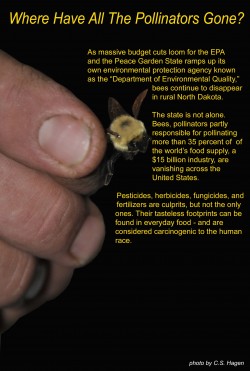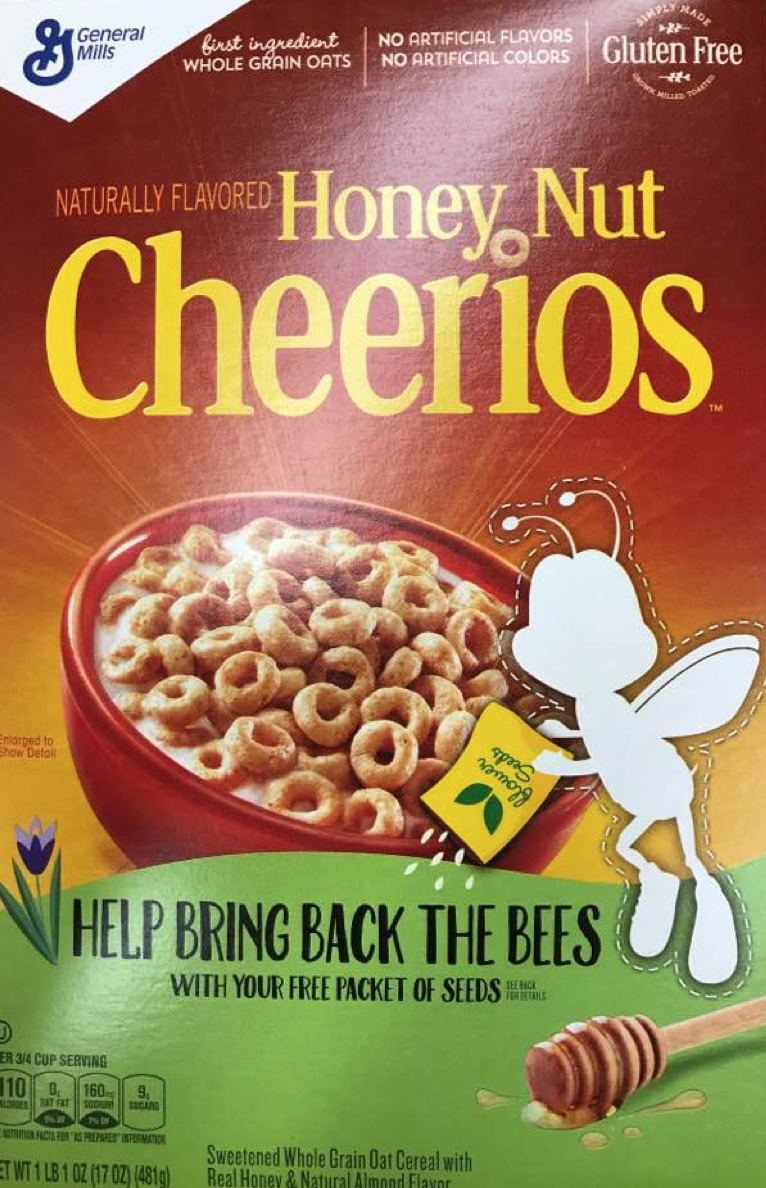News | May 24th, 2017
Katrina Klett grew up running in fields with bees stinging her bare feet. Her parents constantly reminded her to put on shoes, but she rarely listened.
 Today, the family company she helps run in Jamestown, Klett Beekeeping, has more than 1,200 commercial bee colonies. She lives in southwest China, but returns home to help her father during the busier months. More than 10,000 miles away and at an elevation where any Red River Valley native would demand an oxygen tank, her main calling is with Elevated Honey Co., near the Himalayan Mountains in Yunnan Province, China.
Today, the family company she helps run in Jamestown, Klett Beekeeping, has more than 1,200 commercial bee colonies. She lives in southwest China, but returns home to help her father during the busier months. More than 10,000 miles away and at an elevation where any Red River Valley native would demand an oxygen tank, her main calling is with Elevated Honey Co., near the Himalayan Mountains in Yunnan Province, China.
To Klett, bees are a part of her family. She learned the trade secrets from her father, from university professors, from Chinese mentors, and despite recent government attempts to bring back the honey bees, they’re still disappearing, she said.
“The overall decline of the honey bee is continuing,” Klett said. Her family loses approximately 30 percent of their bees every year. “And the overall losses that beekeepers take during the winter months is still not sustainable.”
The killers are elusive. She points to pesticides, herbicides, fertilizers, but also to Asian parasites brought over from Korea in 1987 and most importantly, a lack of conservation lands, rich in diversity.
“It’s truly not a smoking gun,” Klett said. “It’s not fair to say that it’s just pesticides causing these problems, but it’s a large part of it.”
As the nation’s top honey producer and pollination state, North Dakota was also the first to draw up a pollinator plan, North Dakota Agriculture Commissioner Doug Goehring said. It is a plan that will soon be adopted in 43 states.
In North Dakota, sometimes the prairies are covered as far as the eye can see with only one crop.
“The big problem in the United States is that we have this very large-scale agricultural system and bees find it hard to live in it,” Klett said. Herbicides and fertilizers and other chemicals are used to breed out unwanted plants, creating rows and rows of homogeneous corn, alfalfa, sugar beets.
Nutrition in North Dakota is the biggest issue, Goehring said. “They [beekeepers] go and flood an area with pollinators where there may not be enough species, and enough pollen, and enough vegetation to support those bees.”
Colonies of bees are up across the state, Goehring said, from 480,000 colonies to 620,000 colonies.
The number of colonies may have increased, but the bees are still disappearing, Klett said. “It is important to differentiate between Colony Collapse Disorder and the overall quality of health in bees that is going on.”
Few such killers exist in China, Klett said. High up in the mountains, most farms are family-owned, smaller and diverse in scale, offering bees a kaleidoscope of nectars and pollens. Most produce in China should not be eaten raw, as many farms still fertilize with “honey buckets” or human waste. Rice paddies hemmed by poppy, wildflowers, and sunflowers, growing next door to tiered layers of corn -- the traditional Chinese farmer’s methods.
Additionally, restrictions of the Conservation Reserve Program were relaxed by the U.S. Department of Agriculture in 2015. The Conservation Reserve Program offers federal money to farmers to remove environmentally sensitive land from agricultural production and plant species that will improve environmental health and quality. Such policies are shrinking the honey bee’s menu, according to Klett.
 Bees are not only the producers of honey, they help pollinate more than 35 percent of the world’s food supply, according to the Food and Agriculture Organization of the United Nations. Pollinators, including bats and birds, are crucial to the survival of more than just honey.
Bees are not only the producers of honey, they help pollinate more than 35 percent of the world’s food supply, according to the Food and Agriculture Organization of the United Nations. Pollinators, including bats and birds, are crucial to the survival of more than just honey.
The combination of a lack of nutrition, diversity, and Asian parasites, is lethal, and weakens bees, leaving them highly susceptible to chemicals used by farmers, Klett said.
As recent as March this year, General Mills joined the fight against herbicides by pulling their mascot “Buzz” the bumblebee from their boxes of Honey Nut Cheerios as a reminder that the world’s population of bees is plummeting. The company has also sent out free seed packets, a move many find to be controversial and doing little to help the crisis.The main herbicidal producer in America, the Monsanto Company, declares itself a farmer-empowering agricultural company and a producer of seed brands like corn, cotton, oilseeds, fruits, and vegetables. Monsanto also manufactures Roundup-branded herbicides for farmers and lawns, according to its website. Roundup products are a known stressor of bees, according to media outlet Natural News. Glyphosate, the primary ingredient in Monsanto’s herbicide, eliminates bees’ instincts to feed and confuses olfactory memory.
Certain types of bees have been placed on the endangered species list, and as of January 2017 some have been nearly wiped out with one dose of Monsanto’s Roundup products, according to media outlet GMO News.
“Honey bee navigation is affected by ingesting traces of the most widely used herbicide worldwide [glyphosate], with potential long-term negative consequences for colony foraging success,” The Journal of Experimental Biology reported.
Additionally, the same herbicide is known to have negative effects on vertebrates and invertebrates, including earthworms and freshwater snails, according to The Journal of Experimental Biology. A 2016 study made public by the U.S. Food & Drug Administration reported that honey samples from across the United States all contain glyphosate, a chemical that is considered a probable human carcinogen by the World Health Organization.
Other chemicals known as carcinogenic to humans are: tetrachlorvinphos, used on livestock and pet flea collars; parathion, now illegal in the USA; malathion, used in agriculture, public health, and residential insect control, and diazinon, current restricted.
Colony Collapse Disorder
Bee losses hit 42.1 percent across the nation, according to a 2015 report made public by the United States Department of Agriculture. Losses are heaviest during the spring and summer months, the time of year farmers spray pesticides, herbicides, fungicides, and use artificial fertilizers on their fields.
Bees hit with fungicide are three times more prone to infection, according to the U.S. Department of Agriculture. In 2013, researchers collected pollen samples from honey bees pollinating apples, watermelons, cucumbers, blueberries, and other fruits and found most samples contained insecticides, herbicides, and that all samples contained fungicide.
The sickness threatens Colony Collapse Disorder, which endangers “not only pollination and honey production but, much more, this crisis threatens to wipe out production of crops dependent on bees for pollination,” according to the U.S. Department of Agriculture. “Pollination is responsible for $15 billion in added crop value, particularly for specialty crops such as almonds and other nuts, berries, fruits, and vegetables.”
The epidemic began slowly after World War II, and more recently noted as isolated incidents when beekeepers reported losses of up to 90 percent of their hives.
“Although pesticides alone have not been implicated as the principal cause of overall pollinator declines, the EPA and the USDA have been working collaboratively to understand the potential role that pesticides may be playing, particularly in combination with other identified factors,” a 2015 report made public by the U.S. Department of Agriculture stated.
More than 87 million acres of corn and 17 million acres of alfalfa are planted in the continental United States each year, and both crops are highly attractive to bees, according to the U.S. Department of Agriculture.
Gary Hart, director of the Center for Rural Health, said he lives in the countryside. Pesticides blown by winds are a concern for him and his family. “Heaven knows, I get the pesticides coming in and we have to shut the windows and hide when they’re blowing,” he said.
The concern about bees is a national worry, he said, and not just for the Peace Garden State.
EPA cuts and the state taking back control
Currently, the Environmental Protection Agency for North Dakota is managed from Denver, Colorado, more than 700 miles away. North Dakota is known as Region 8, and as the EPA prepares to have its budget cut by up to 30 percent, environmental issues in the state could have “severe” implications, according to the Environmental Defense Fund.
“North Dakota has a lot at risk,” Steve Hirsh of the Environmental Defense Fund said. “A half-million people in the state rely on headwater, rain-fed and seasonal streams for drinking water.”
The cuts are a Republican effort to deplete federal authority and push local management back onto cash-strapped states, according to Hirsh. Goehring prefers the term “cooperative federalism,” he said.
“This budget, if enacted, will devastate the ability of our state members to clean up the air,” Executive Director of the National Association of Clean Air Agencies S. William Becker said. “I can predict with certainty that if these budget cuts come to fruition, there will be many more people dying prematurely and getting sick.”
“President Trump’s proposed 2018 budget is a full-scale attack on America’s most fundamental health and safety protections,” Environmental Defense Fund President President Fred Krupp said. “It would gut our ability to keep our air and water clean, and would put the health of all Americans at risk.”
North Dakota’s current environmental agencies are a “convoluted complex animal,” and include three entities: the Health Department, soon to severed and become the “Department of Environmental Quality” and will be in charge of environmental issues, the Department of Mineral Resources, in charge of oil and gas development, and the Department of Agriculture, in charge of pesticides and fertilizers, all of whom have primacy, or the lead against federal interference, Goehring said.
“We have cooperation agreements with the EPA, and we have meetings with them once or twice a year and talk about where the federal government is needed, but it ends up being a bit of a battle at times,” Goehring said. “The only thing is, we do receive federal grants to do the work, that's the agreement we have with them, in other words they don’t have personnel out here to do it, and quite frankly we don’t want them up here anyway.
“Don’t tell us you love our land more than we do.”
Grants up to $46 million from the EPA cover a fourth of North Dakota’s air quality monitoring, toxic waste site management, lake and river protection, and manage 128 brownfields, according to the Environmental Defense Fund. Budget cuts proposed by President Trump’s Administration to balance the national debt could reduce lead reduction efforts and exacerbate poisoned waters with runoff pollution from urban streets and energy production, if such programs continue to exist at all.
“Are they cuts that exist within the EPA, or will they be passed on to us?” Goehring said. “We have had some assurances from D.C. that the cuts will be supposedly targeted toward the EPA and not targeted toward the states. Maybe we will experience a few cuts, but most cuts are directed toward the big monster that the EPA is in size.”
Other programs such as fighting cyanobacteria, judicially known as “blue-green algae,” may be threatened. Cyanobacteria are microscopic organisms that bloom in slow-moving water, such as ponds and lakes, and can be toxic for animals and humans, according to the North Dakota Game and Fish Department. If such toxins are ingested, there is no cure, and very few laboratories that can test for cyanobacteria.
Bakken earth is poisoned, according an April 27, 2016 study released by Duke University, funded by the National Science Foundation, and the Natural Resources Defense Council, and pu blished in the Environmental Science & Technology magazine. The study shows that accidental wastewater spills from “unconventional oil production in North Dakota have caused widespread water and soil contamination.”
blished in the Environmental Science & Technology magazine. The study shows that accidental wastewater spills from “unconventional oil production in North Dakota have caused widespread water and soil contamination.”
Much of the poisons comes from brine or saltwater used in fracking, and is non-biodegradable.
In a move some call wise, state legislators passed Senate Bill 2327 shortly before the end of the 2017 legislative session. The bill was introduced by Republican senators Jessica Unruh, Kelly Armstrong, and Rich Wardner, and Republican representatives Al Carlson, Keith Kepmenich, and Todd Porter.
The bill transfers all state authority, powers, and duties related to environmental quality to the newly-formed “Department of Environmental Quality” before July 1, 2019. The new department’s duties will include oil drilling regulations and to pesticide and radioactive “byproduct material” management. Also included under the department’s purview are zoning regulations, or setback distances between livestock, residential, and agricultural operations, and the licensing, management, and custody of radioactive and hazardous wastes and underground storage or regulated substances.
The council is to consist of nine members appointed by the governor, including four people in the healthcare field and five people representing consumer interests, according to Senate Bill 2327. The director of the department will “serve at the pleasure of the governor,” must have a bachelor of science degree or higher from an accredited college, and may not engage in any other occupation or business that conflicts with statutory duties.
The North Dakota Century Code was amended to reinforce Department of Environmental Quality as the public health authority in the state, trumping the EPA.
Communication and location are the keys
Beekeepers need to look for locations with plenty of diversity and water, Goehring said. “Bees need water just like any other animal. Look to soil health, especially for vegetables and flowering plants.”
Phosphorus, nitrogen, and potassium, as well as other minerals are needed for plant virility and diversity, and the more diverse an area is, the faster bees will thrive. Chemicals, although harmful, aren't the main factor behind bee disappearance, Goehring said.
“A lot of pesticides that farmers use won’t even harm bees, but there are a lot of insecticides that will,” Goehring said. Beekeepers and bees are farmers’ guests, and there needs to be good communication between agriculturalists and beekeepers.
Klett added that the federal government should assist more with communication incentives, and the tightening of regulations on Conservation Reserve Programs. “One of the biggest problems is the complete loss of bee habitat in the countryside.” Most of the time farmers care about beekeepers, although some beekeepers have reported careless farmers. “For the most part, they really want to work with us and help us out. Big fruit and vegetable producers need our services, but we’re finding out that if there isn’t a pesticide free habitat then the bees get sick and they don't do well.
“It’s a rock and hard place.”
China’s farmers may possess the only true antidote for bee virility, and the answer lies in diversity. “China is one of the most diverse places for honey bees in the world,” Klett said.
“Beekeeping is an interesting form of agriculture. You can't make it mechanized. You have to have someone who really understands bees. There are just 1,000 or so families providing most of the pollination services and to an extent, they are largely invisible.
“I would like to see a good Conservation Reserve Program come back. Commodity prices are down, this would be a great time to do that.”
April 18th 2024
April 18th 2024
April 18th 2024
March 21st 2024
February 15th 2024





